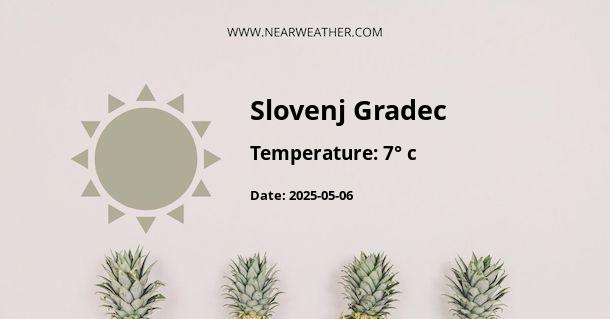Introduction to Mestna Občina Slovenj Gradec's Climate
Mestna Občina Slovenj Gradec, located in northern Slovenia, is a city known for its rich cultural heritage and historical significance. As we delve into the climate characteristics of Slovenj Gradec, it is pivotal to mention that its weather patterns are greatly influenced by its geographical positioning within the subalpine region. The city experiences a continental climate with distinct seasonal variations and is subject to the interplay between maritime and continental air masses.
Seasonal Climate Overview
Winter
Winters in Slovenj Gradec are typically cold and snowy, with temperatures often dipping below freezing. January is generally the coldest month, with average low temperatures hovering around -5°C. Snow cover is common, which supports various winter sports activities in the region.
Spring
As the season transitions to spring, temperatures gradually rise with the occasional influx of warmer air masses. However, spring can still be unpredictable with late frosts and sudden temperature drops, particularly in March and April. The average temperatures in spring range from 5°C to 15°C.
Summer
The summer climate is pleasant and warm, with July and August being the hottest months exhibiting average high temperatures of around 25°C. Yet, the city's elevation can lead to cooler nights even in the summer. Moreover, summer also brings about the majority of the annual precipitation, often in the form of afternoon thunderstorms.
Fall
Fall sees a gradual cooling trend, with a mix of sunny days and increasing precipitation. Temperatures in September are generally mild, but by November, they have fallen to a cooler range akin to that of early spring.
Annual Temperature and Precipitation Statistics
The climate data for Mestna Občina Slovenj Gradec indicates a mean annual temperature in the range of 8°C to 9°C, with seasonal temperature fluctuations that are typical for a continental climate zone.
Temperature Tables
| Month | Average High (°C) | Average Low (°C) |
|---|---|---|
| January | 1 | -5 |
| February | 3 | -3 |
| March | 8 | 0 |
| April | 14 | 4 |
| May | 19 | 8 |
| June | 22 | 11 |
| July | 25 | 13 |
| August | 24 | 13 |
| September | 20 | 10 |
| October | 14 | 6 |
| November | 7 | 1 |
| December | 2 | -3 |
Precipitation Charts
| Month | Average Precipitation (mm) |
|---|---|
| January | 40 |
| February | 35 |
| March | 70 |
| April | 80 |
| May | 100 |
| June | 120 |
| July | 110 |
| August | 100 |
| September | 140 |
| October | 130 |
| November | 100 |
| December | 50 |
Weather Influences and Phenomena
The proximity of Slovenj Gradec to the Alps has a moderating influence on its climate, often resulting in more precipitation due to orographic lifting as air masses ascend over the mountainous terrain. The relief also contributes to the occurrences of föhn winds, especially in the spring and fall months, which can lead to dramatic temperature rises and drops within short periods.
- Northerly Winds: The area is occasionally subjected to cold northerly winds, which can lead to significantly lower temperatures and increased snowfall in the winter months.
- Thunderstorms: In the summer, the convergence of warm and moist Mediterranean air with cooler continental air can result in severe thunderstorms with heavy rainfall, occasionally leading to flooding.
- Temperature Inversions: During the winter, temperature inversions are common, especially in settled weather conditions, trapping cold air in the valleys and leading to persistent fog and low cloud cover.
Slovenj Gradec's Micro-climate Variation
Given its varied topography, Slovenj Gradec exhibits local micro-climates. Valleys may experience cooler conditions with more fog, while elevated areas tend to have milder temperatures and more sunshine. These micro-climate zones influence local weather patterns and have a direct impact on agriculture, viticulture, and other outdoor activities within the municipality.
Climate Change Considerations
As with many regions worldwide, Slovenj Gradec is also experiencing the effects of climate change, which includes an increase in average temperatures and changes in precipitation patterns. The potential for extreme weather events, such as heatwaves and heavy rainfall, is on the rise, posing challenges to the region's infrastructure and ecosystems.
It is crucial for local authorities and planners to factor in these changing climate trends in urban development and environmental protection strategies to mitigate the potential impacts on the community and natural resources of Slovenj Gradec.
Conclusion
In summary, Mestna Občina Slovenj Gradec showcases a continental climate with influences from the nearby Alps. The weather is characterized by a range of seasonal variations, from snowy winters to warm summers, with an overarching presence of micro-climates. Understanding the intricate nature of Slovenj Gradec's climate is essential not only for residents and visitors but also for fostering sustainable development in light of climate change pressures. Recognizing and preparing for the shifting weather patterns will play a vital role in preserving the city's charm and livability for future generations.
A - Slovenj Gradec's Latitude is 46.488609 & Longitude is 15.083610.
A - Weather in Slovenj Gradec is 11° today.
A - Climate Conditions in Slovenj Gradec shows overcast clouds today.
A - Humidity in Slovenj Gradec is 81% today.
A - Wind speed in Slovenj Gradec is 4.1 km/h, flowing at 65° wind direction. today.
